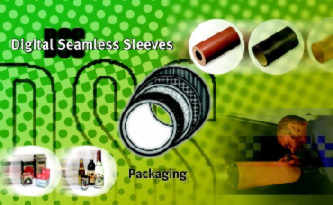
Only use sleeveless plates to plate.
However, if the answer is to use an analog method, that is, through the film to the seamless sleeve-type printing plate, to avoid seams on the plate, it is not an easy task. Only with digital technology, data directly from the computer to the printing plate upswing, then to be seamless, in order to be easy.
Flexographic printing is a common printing process for packaging and decorative printing, and often encounters such printing requirements. In the early years, flexo printers often found it difficult to meet such prints. However, since the CTP technology was adopted to manufacture seamless sleeve-type flexo plates, such problems were solved.
The basic plate making method of DSS (Digital Seamless Sleeves) digital jointless sleeve printing plate is as follows:
first step
Put a layer of hot-melt adhesive on the space nickel or other metal roller. After drying, fix the photopolymer plate that has been cut to the metal roller and put it on both ends of the roller. The core is evacuated (the surface of the roller has many small holes), so that the photosensitive plate is tightly attached to the surface of the metal roller. It is then placed in an oven and warmed to fuse the plate with the adhesive layer on the surface of the metal roll and then removed for cooling. 
Second step
Put the first cooled version of the sleeve into the peripheral grinding machine. According to the size requirements of the print, grind the outer diameter of the sleeve to a certain diameter (detected by the laser). The layout is naturally smooth. After wiping it clean, apply a black coating to the sleeve plate surface. Let it dry and set aside.
third step
Digitally laser-scanned (CTP) the second-stage prepared sleeve plate, so that the black coating on the sleeve plate is thermally etched by laser, and then exposed to UV light as usual (same as normal flexographic UV exposure) .
the fourth step
Place the exposed sleeve plate in the corrosive tank for flushing, then remove and blow dry. It can be proofed and submitted for use.
What happened to the DSS investment in the flexo market? The United States OEC Corporation was the first company to formally adopt DSS technology in 1997, and its development experiment has begun in the early 1990s. In the US flexo printing market, more than 10 sets of such platemaking systems have been put into use now, providing platemaking services for hundreds of flexographic printing companies, including both narrow and wide formats. The US-renowned Kraft Foods flexible packaging has changed the packaging printing on one production line to DSS digital seamless sleeve printing, and is also preparing to convert all of its product packaging printing to DSS technology in 2001 (regardless of offset printing Or flexo, or other printing methods). Moreover, according to the expectations of professionals, DSS technology will be further welcomed and promoted because of the following reasons.
Rotating Wheel For Hard Sheel Suitcase
Rotating Wheel For Hard Sheel Suitcase,Soft Luggage Wheel,Travel Luggage Big Wheels,Wheel For Trolley Backpacks
GUANGDONG SUNDES LUGGAGE ACCESSORY TECHNOLOGIES CO.,LTD , https://www.guangdongsundes.com